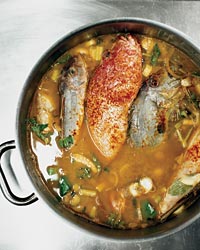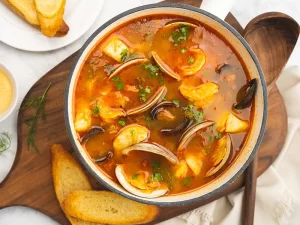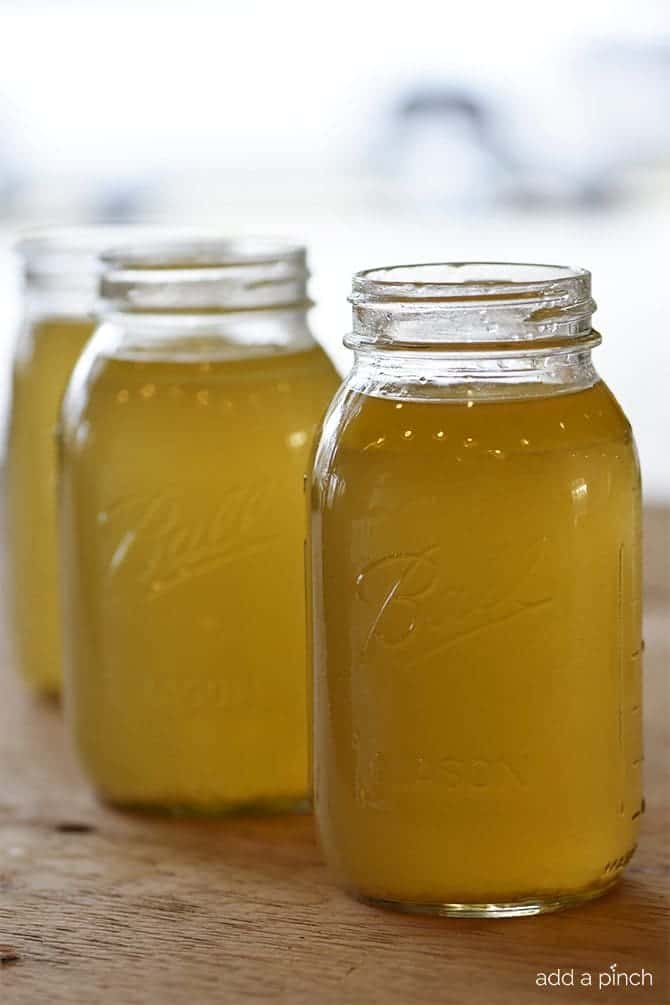You’ve probably heard of Bouillabaisse, the famous French seafood stew. It is considered by French chefs to be one of the great challenges in the kitchen. But perhaps you also know that it wasn’t always that way. Like most of the best dishes from around the world, bouillabaisse was originally a peasant dish.
The dish we know today clearly originated in Marseille, France and the name comes from two words meaning boil and simmer. But the origins of the stew go back much further, to ancient Greeks who founded that French port city. They ate a simple fish stew called kakvia. Naturally, the Romans had a similar dish.
Bouillabaisse in its modern form comes from Marseille fishermen who used the common rockfish and shellfish that got caught in their nets, while the more expensive fish were sold. That mostly worthless part of their catch was cooked in a large pot or cauldron filled with seawater, garlic, and fennel. This was cooked dockside over an open wood fire. After tomatoes arrived from America, they were added to the recipe.
As the Provencal region prospered, bouillabaisse began showing up on restaurant and hotel menus. Fish stock replaced the seawater. Saffron and local vegetables were added. The name means boil then simmer, and that’s the cooking method. The broth is boiled and then the heat is lowered to a simmer.
There are many recipes available. Each great chef seems to have developed their own version of this dish. But here’s a simple one from Austin, Texas’ Trace restaurant.
Servings: 2
Ingredients
- 2 tablespoons olive oil
- 2 medium carrots, one chopped and one sliced into batons
- 1 stalk celery, chopped
- 1 fennel bulb half chopped and half shaved with a mandolin or V-slicer, fronds reserved for garnish
- 1/2 small red onion, chopped
- 1 clove garlic, minced
- 2 ripe plum tomatoes, chopped
- 1 teaspoon tomato paste
- 2 1/2 cups chicken or vegetable stock
- 1/2 cup parsley leaves, loosely packed
- 6 jumbo Gulf shrimp, peeled and deveined with the tail shell on
- 12 large freshwater mussels, scrubbed well
- 1 large red potato, peeled and cubed
- 1 6- to 8-ounce fillet red snapper, cut in half
Directions:
- Heat 1 tablespoon of olive oil in a large saucepan over medium-high heat.
- Saute chopped carrots, celery, chopped fennel, onion, and garlic for 5-7 minutes, stirring frequently, until softened.
- Add tomatoes and cook for another 3-5 minutes until tomatoes begin to dissolve. Add tomato paste, stock, and parsley, stir well to combine, bring to a simmer, and cook for 10 minutes.
- Drop in mussels and shrimp, place the lid on the saucepan, and cook until the shrimp is opaque all the way through and the mussels have opened — about 2-3 minutes.
- Remove shrimp and mussels, discard any mussels that haven’t opened, and set aside.
- Strain the mixture through a sieve or chinois, pushing down with a wooden spoon to extract all the liquid, and return to the pot. Discard what’s left in the strainer.
- Add potatoes, shaved fennel, and carrot batons, bring to a boil, cover loosely with a lid and cook at a vigorous simmer until potatoes are tender — about 10 minutes.
- Meanwhile, heat the other tablespoon of olive oil in a medium skillet over medium-high heat until very hot, almost smoking.
- Sprinkle the snapper pieces with salt on both sides and sear in the hot pan for 2-3 minutes on each side.
- Divide broth with carrots and potatoes between two deep bowls, arrange shrimp and mussels on top, and top with a piece of snapper.
- Garnish with fronds from the top of the fennel bulb and serve.
Level of Difficulty: Moderate; Prep Time: 25 minutes; Cooking Time: 50 minutes




